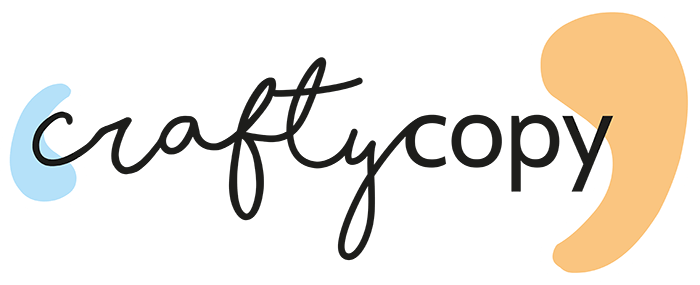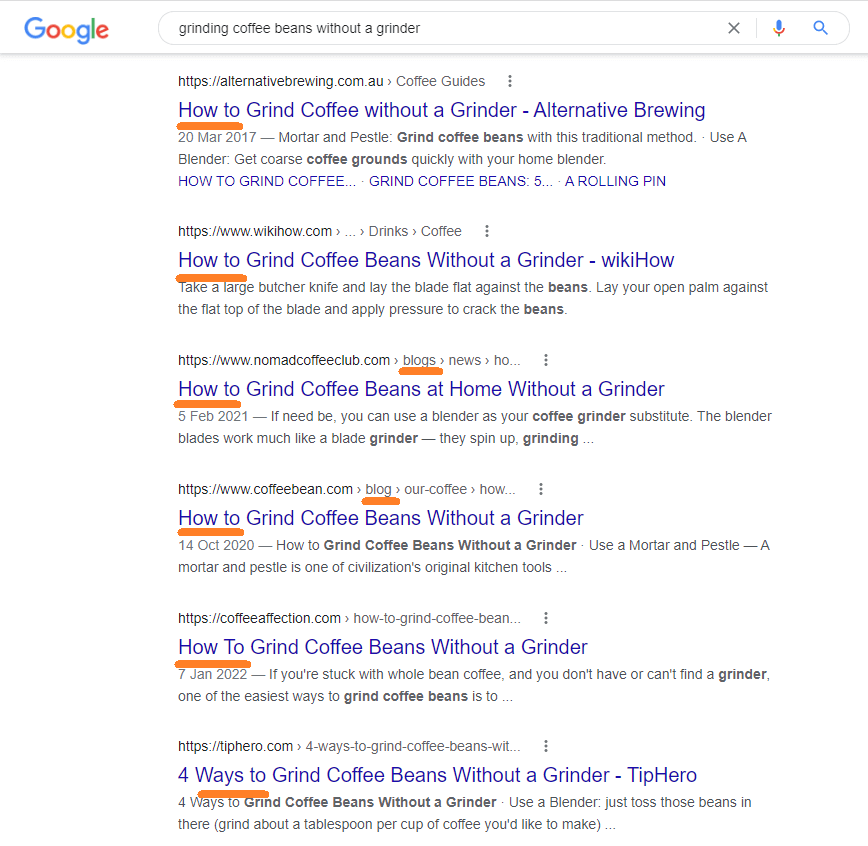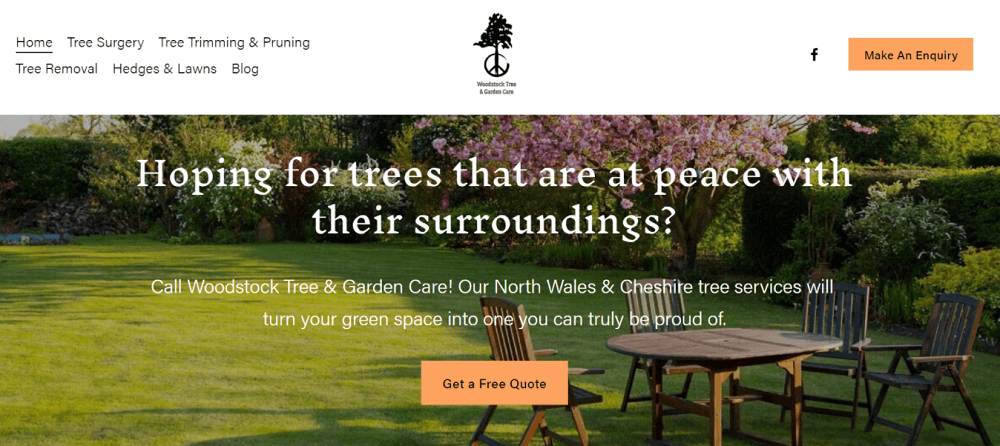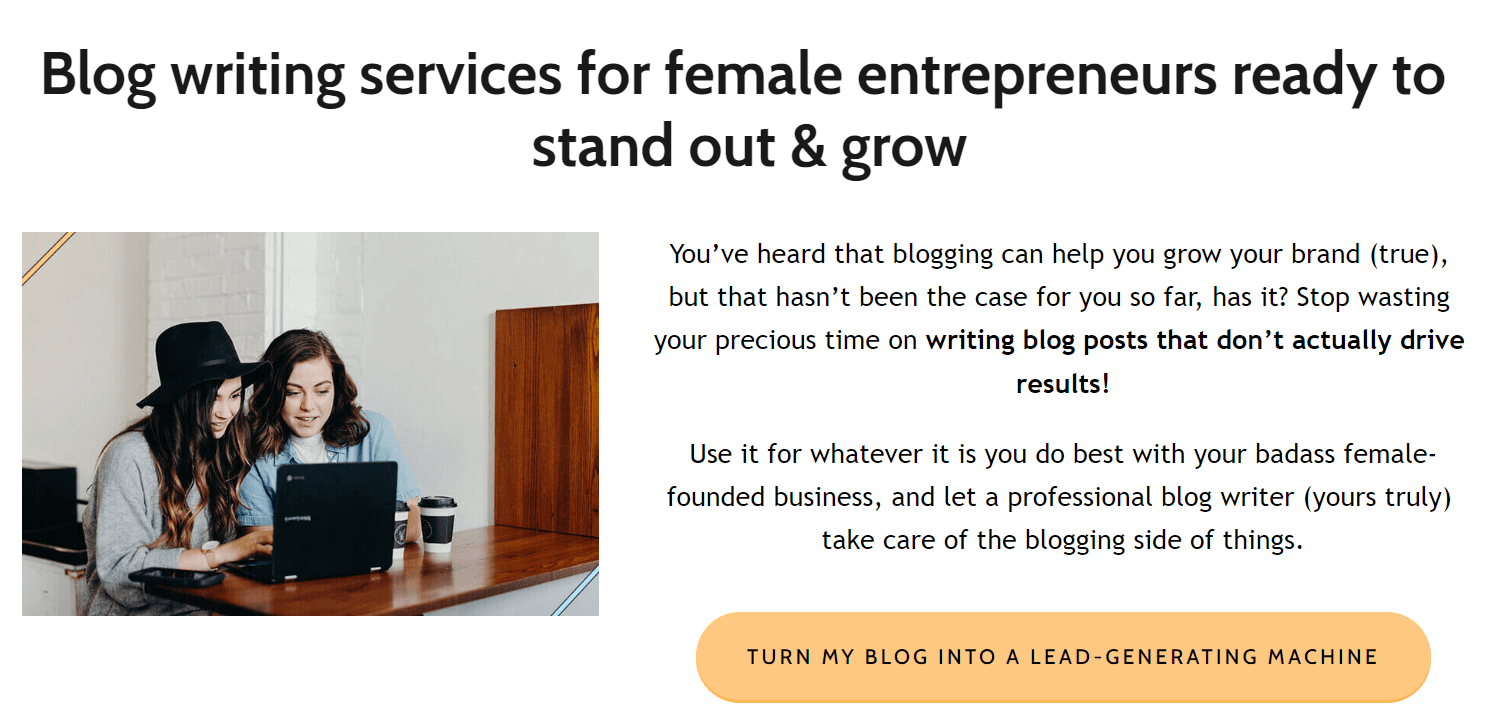How Long Should Your Web Pages Be? (Size Matters!)
The importance of the right web page length shouldn’t be just about SEO! Here’s how long your web pages should be and what to focus on, too.
You’re probably wondering how long should a web page be so that it can rank higher on Google, but here’s the thing: the optimal web page length for your business website shouldn’t be just about SEO.
Let me show you what you should focus on for the best results and conversions.
Understanding optimal web page lengths
From your home to landing pages and your contact section, here’s what to consider when writing your website copy.
How long should a web page be for SEO?
Take if from a professional website copywriter: when it comes to SEO, a web page should be at least 300 words long.
This is because Google tends to classify anything below that word count as ‘thin’ or ‘low-quality’ content.
Think about it: whenever a user types a keyword or some kind of query (e.g. in our case ‘how long should a web page be?’), this search engine wants them to find the best possible answer.
Can that really be given in less than 300 words?
Unlikely.
If, instead of the blog post that you’re reading right now, I had written a couple of paragraphs telling you to aim for at least 300 words, I would not have given you a good enough answer.
Why? Because there’s so much more to take into account!
Google knows this. So, if you try and get away with 150 words or so while most of your competitors dish out 600, 1000, or +2000 word pages, Google is not gonna trust your answer.
“On average, web pages reaching Google’s top results have 1,890 words.”
So, does this mean that the longer the better when it comes to web page length?
Actually, no.
Focus on VALUE over fluff or strict word counts!
While 300 words is an important starting point, you should always focus on writing copy that serves the specific purpose of that web page on your business website.
Because this varies, there isn’t a one-size-fits-all answer for web page length.
There is absolutely no point in stuffing your web pages with useless or repetitive sections, nor using twenty words when four could do just so you can obtain a longer word count.
No point.
You’re just going to bore or scare your readers away… and that will backfire from an SEO point of view too. If too many visitors abandon your website too quickly, you’ll end up with a high bounce rate, and Google doesn’t like that.
“So, the most important thing is to write copy that serves the specific purpose of that page. ”
And let’s be realistic: from your home to your About or a Sustainability page, that will be over 300 words. Even if you’re not actively striving for that number.
A popular exception is the Contact page: I mean, do you really have that much to say by that point, other than a couple of paragraphs that further encourage your visitors to get in touch?
I doubt it.
I mean, if you do, that’s great. But, if you don’t, don’t worry: having one or two pages that are shorter than 300 words isn’t going to penalise you on Google.
Just as long as your core pages (e.g. home, about, services, etc.) are a bit longer.
How long should a landing page be?
There’s no right length for sales or landing pages. However, while they should still be at least 300 words (like other standard pages) from an SEO point of view, it’s only logical to have much longer landing pages.
Why?
Because they must be optimised for conversions and move your visitors aaaaaall the way down the funnel.
Can you really do that in 300 words?
Maybe, if those who find your landing page are already towards the bottom of the sales funnel.
In most cases, however, the answer is a big fat NO.
“My rule of thumb is: the more you’re asking of your visitors, the longer your landing or sales page should be.”
Are you asking them to give you their email address in exchange for a free ebook? That’s not a big commitment, so a fairly short landing page will do.
Are you asking them to invest thousands of pounds into your high-ticket programme? Then your landing page will need to be waaaaaaaaay longer.
Not for SEO reasons, but simply because… well, you must convince these people to part with thousands of pounds!
And, for this to happen, you’ll need to:
agitate their current pain points
tackle all of their most common worries and potential objections
show social proof
paint an irresistible picture of what their reality will look like once they’ve invested in your products or services
Basically, you need more words.
Best practices when it comes to web page length
While I always recommend remembering that magic number (a minimum of 300 words), here’s what you should actually focus on when writing copy for your business website.
1. Write excellent copy where EVERY. WORD. MATTERS.
Here’s the thing: when it comes to word counts, best practices change, and people have more opinions than on the Game of Thrones finale.
For real.
While 300 words is a consistent number since it’s one of Google’s ranking factors, you’ll find blog posts telling you to only publish content over 1000 words.
No, actually, 1500.
No, wait! +2500.
Honestly? Forget about all that.
“The way you talk about your business and bring your dream customers into your brand story is what matters the most.”
So, focus on strategic website copy that grabs your audience’s attention, show them why you’re the best at what you do, proves how your products or services can benefit them, and helps them move down the funnel.
That’s it.
Don’t get too hung up on specific word counts!
2. Make your above-the-fold copy unmissable
Regardless of how long a web page should be and all that, let’s be realistic: nobody will read the entire thing if the first part doesn’t hook them in.
Your above-the-fold content consists of everything that your website visitors can see before they scroll down.
Its aim is to convince them to stick around and read the rest, which is why it’s the most important part of your page. No wonder users spend over half of their page-viewing time above the fold!
For example, when it comes to your home page, your above-the-fold copy should convey:
Exactly what you do
For whom
Why that matters/how it benefits your target audience
3. Use headings
Nobody likes a page full of lines and lines of text in the exact same size!
You need to use headings to help your readers read or skim your page without getting put off by a huge wall of text.
Plus, headings are excellent for SEO, too: they’re ideal to create a hierarchical structure and use your keywords strategically.
4. Break up your text even further
Headings aren’t the only way to break up your text.
For example, to further facilitate readability you could use:
Bullet points (how meta!)
Different sections
Images
CTA buttons
No matter how long your web pages are, using these tricks (together with the right copy, of course) will help readers stick around and take action.
Grab the right words for your female-founded business website
Now that you know how long web pages should be (and why it doesn’t always matter that much), you have two options: write them on your own, or outsource them to a professional.
If you’re a fellow copywriter, the first option makes a lot of sense.
Not your area of expertise?
I’m a website copywriter & brand messaging consultant turning female entrepreneurs into THE go-to solution in their dream audience’s eyes.
My copy will allow you to attract more visitors organically, turn them into leads and sales, and stand out against your competitors.
Let me fill your website with copy that brings actually results, not just ‘words on a page’.
More #crafty blog posts on this topic:
Using Images in Blog Posts: Complete Guide for Businesses
You should always use images in blog posts, but where can you find them? How big should they be? And how do you optimise them for SEO? Let’s see.
Do you use images in blog posts?
I always thought it was a no-brainer, and yet I keep bumping into incredibly offputting text-only articles.
At the same time, chucking a bunch of random images without resizing them nor following a strategy isn’t going to benefit your company blog either.
So, let’s look into how to do it properly.
Should blog posts have images?
Yes, blog posts should DEFINITELY have images… unless you want to scare your readers away with a huge blog of text, that is!
No wonder articles with pictures get 94% more views than those without them.
Adding images to blog posts comes with quite a few benefits:
They complement your written content, helping readers visualise certain concepts, find visual summaries, or make the most of infographics
They break meaty sections of text, making it easier to read long articles
They offer SEO opportunities through their alt-text tags (more on that later)
In some cases, images in blog posts can even help you reinforce your brand
What type of images should I use in my blog posts?
You have several options when it comes to looking for and using images in your blog posts, and they mainly depend on your time and budget.
So, don’t worry:
if you’re just starting out or have already invested a lot of money in something else, you DON’T necessarily need to pay hundreds of pounds every month for custom images. I promise!
I’m gonna give you different options on how to create or find images for blog articles… for all kinds of needs and budgets (including £0).
Stock images
Stock photos are a fantastic way to start adding images to blog posts, and I’ll be honest: in many cases, they might be all you need.
You just have to make sure that you’re not using someone else’s pictures illegally.
Some terms are confusing—which doesn’t help—so let’s clarify them once and for all:
Royalty-free images aren’t necessarily free: they just mean that you don’t have to pay an on-going fee to use them, but you might have to buy the images in the first place. For example, you can find royalty-free images for which you only pay a one-off fee on Shutterstock
Copyright-free images can be used without limitations. While there might be fewer and less specific options compared to paid royalty-free platforms, you can still find a ton of free images that you can use legally without getting in trouble. For real. Some of my favourite websites for high-quality free images for blog posts are Unsplash, Pexels, and Pixabay
If you want to take your stock images to the next level to maintain a cohesive feel that’s on brand, you could also:
Look for photos including your brand colours
Use pictures with a similar palette (e.g. all with a white background or pastel colours)
Stick to a specific vibe, such as minimalist pictures with a single element or two
Shoot your own
If you have the resources for it, you can stand out even more by shooting your own pictures.
For example, you could use photos of your own restaurant or food items even if you’re tackling wider culinary topics.
In many cases, it’ll even make sense to include your actual product pictures. Maybe you’ve written an article on “the benefits of linen bedding” and you actually sell linen bedding yourself… it’d be crazy not to include a picture of it and a link to its product page, right?
Include screenshots in tutorials
Sometimes, screenshots might be relevant for your blog posts, and that’s especially the case for online tutorials.
If you’re explaining to your readers how to edit a picture on Photoshop, it’d be much easier and more effective to add a screenshot with arrows and circles that highlight the next step… rather than trying to explain everything with words.
Use editing software or platforms
If you have enough time to dedicate to them but not a great budget, you can create your own images using either free or paid graphic tools.
These are especially useful for infographics—an excellent type of highly shareable images for blog posts!—as well as graphs and images that summarise key concepts.
Although you can pay for premium features, Canva is the most popular free option. Other alternatives to create your own images for blog posts are Visme, Adobe Creative Cloud Express (formerly Adobe Spark), Design Wizard, and Easil.
Commission them to a graphic designer
Would you rather save time than money? Then the best and most professional option is obviously to get a professional to create images for your blog posts, and especially to keep them on brand.
This could be an in-house graphic designer, a freelancer with whom you only collaborate when you actually need some new images, or platforms to which you pay a monthly retainer (like Design Pickle).
Best practices when using images in blog posts on your business website
So, we’ve established why you should totally use images in your blog posts and understood where to find them.
Is that enough to use them successfully?
Nope.
Here are some steps that you just can’t afford to ignore.
1. Only upload high-quality images
Some badly cropped or pixelated pictures aren’t going to do you any favours!
Remember: you’re not using images in blog posts just for the sake of including them. You’re using them to add value to your readers.
Would Coca Cola or IKEA use crappy images on their website?
No, and neither should you.
Stick to high-quality options that help you look professional.
2. Resize & compress your blog post pictures
Super high-quality images are a must… but they can actually backfire if you don’t upload them correctly!
This is because they’re heavy, so they’ll end up slowing down your page loading time. And nobody has got time to wait an additional three seconds online in the 21st century.
So, here’s what to do before uploading these images:
Resize them: no point in using a huge and heavy 4000-pixel image when the average screen width is 1920 pixels. And your images might not need to be that big either: maybe your blog page is actually a little smaller? Maybe you’re adding text around them so they’ll only need to be 700 pixels or so in width?
Compress them: even after being resized, pictures are heavier than they should be because they carry additional information that you don’t actually need. Websites like TinyJPG allow you to get rid of them without compromising on quality
Use plugins: this might be more or less relevant depending on what platform you’re using to host your business website. For example, when you add photos to WordPress blogs, it’d be handy to use plugins like EWWW Image Optimizer or Imagify
Consider using a CDN. This isn’t just useful for images: it simply helps you reach users worldwide with the fastest loading speed possible, but it’s even more relevant if you’ll be using lots of images on your website since they all add up. Some of the most popular providers are Cloudflare and CloudFront
3. Understand where to use images in blog posts
Here are my main tips on how to place images in blog posts strategically:
Include a blog post header image: this will be the main picture for a specific blog post, and it’ll appear above the fold (before your users scroll down)
Use your images to break up your body of text
If your platform doesn’t automatically use your header image on socials, include a social sharing image, too: that way, when you or your readers share your blog post on social media, it’ll appear with a relevant picture rather than your logo
4. Include relevant alt-text
Remember when I mentioned that images are good for SEO?
This is because they offer you yet another chance to include relevant keywords through their alt-text tag.
This doesn’t mean that you should just repeat your keyword over and over again!
Only when it actually describes the picture.
For example, if your main keyword is ‘styling vegan dresses’ and you’re including a picture of someone showcasing one, your alt-text could be ‘model styling a vegan dress with a denim jacket’.
Basically, when you do it properly, using images in blog posts will benefit your SEO, readers, and overall content strategy!
Need a hand with the blog on your female-founded business website?
Are you guilty of forgetting about the blog on your business website for months? Not sure how to optimise your articles for SEO so that they can actually reach people via Google?
I can help!
Check out my blog writing services making ambitious female entrepreneurs become THE go-to solution in their audience’s eyes.
I have options for all kinds of needs depending on how much you want to be involved with the process.
Tell me all about them by booking a strategy session to receive a blueprint and custom quote.
And if you’ve found this guide helpful, start receiving more tips and content prompts for your female-founded business.
More #crafty blog posts on this topic:
How Your Company Blog & Social Media Can Team Up
Still thinking of your blog & social media separately? Nuh-uh. Here's all the magic that'll happen for your woman-founded biz once they complement each other.
Hey, fellow female entrepreneur: do NOT think of your company blog and social media marketing as two completely separate channels that never meet! They’re not parallel lines.
Social media and blogging should actively complement each other.
So, if you’ve been posting occasional articles on the blog on your business website and working on your social media plan separately… think again!
First things first: not that kind of company blog!
The strategy that I’m about to explain to you is only relevant if your blog has a content marketing strategy behind it.
You know, if it consists of audience-oriented articles that entertain and/or educate your dream customers by tackling topics that are relevant to your industry.
Is your blog filled with company news instead? Articles like “Check out our new office” or “We’re delighted to announce that”?
Then don’t bother.
Because nobody is reading them anyway.
Ouch.
Sorry, but there’s no point in you wasting even more time by using these social media and blog posts together if these are the kind of articles you publish.
So, if that’s the case, start by rethinking your blog altogether and focusing on articles that bring value to your customers rather than stroking your ego.
Here’s how to create a successful company blog.
Once you’ve done that (or if you were already blogging with that strategy), keep reading.
How can blogging complement social media marketing?
Blogging can complement your social media marketing by giving you more long-form content to post and share with your audience, providing your followers with more variety and in-depth topics.
But that’s not all!
Let’s look into how social media and blogging can work together.
1. Blogging provides you with more in-depth content
Social media is about playing to the platform, so I’m sure you’re already posting snappy tweets, showstopping Instagram images and videos, or even some funny TikToks.
However, some of your followers are the exact same people googling the topics around which you’ve built those blog posts!
Sure, some of them will still find them on Google if you’ve optimised them for SEO correctly, but sharing them on social media will allow you to reach more people.
And you’ll keep your followers interested by giving them even more valuable content.
Just be sure to keep an audience-oriented approach when sharing links to your blog posts, though.
None of those “Be sure to check out our new article.”
What’s in it for them?
For example, if you wrote an article on rayon fabric, you could write something like this when you share it on your social media: “Smooth as silk… but a lot more ethical! Discover how switching to rayon can make a difference for both your wardrobe and the planet.”
2. You can repurpose it, too
As well as sharing and linking to your blog post on social media, you can use snippets of it for future posts and pictures.
From quotes to data and pieces of information, an article will provide much more in-depth knowledge on a specific topic: use it for different bite-sized posts, too!
3. You can also post some images and videos that you created for that blog post
If you’ve created an infographic or a video to go with your article, don’t you dare waste it by using it only once!
Just like you’d post pull quotes from it or turn them into shareable pictures, you can add visual content from your blog to your social media, too.
4. Start a conversation on a specific subject
Here’s the thing with company blogs: people read them, bookmark them, fall in love with the brand behind them, subscribe to the newsletter that’s linked at the bottom… but they rarely comment.
I still recommend having a comment section at the bottom of your posts. After all, you don’t want them to feel like a one-way lecture.
But yeah, people don’t comment on them as much as they do on social media.
By sharing the same article on socials, though, you’ll get to start a conversation on that subject!
And you probably already know this but the more comments you receive on socials, the more your engagement levels will grow, and the more you’ll reach new users (the algorithm is fussy like that).
5. Encourage people to share your blog on social media themselves
If you’re blogging the right way and offering actual value, it won’t just be you sharing your own articles on socials: some of your readers will want to do the same!
And that’s basically free marketing for you, as they’ll help you reach people who had probably never heard about you in the first place.
That’s why you should always have some social sharing buttons on your blog.
6. If your blog and social media are consistent, you can reinforce your brand
It goes without saying but I’ll say it anyway because waaaaay too many things are (erroneously) taken for granted when talking about blogs and social media: they should always be on brand.
From fonts to voice and visuals, someone who has been following you on socials should immediately be able to tell that a blog post is yours as soon as they land on it, and vice versa.
So, if you keep blogging and using social media in a consistent way, cohesively, and with a strategy behind them, you’ll appear as even more of a thought-leading expert in your industry.
Your brand will look legit and trustworthy, unlike those companies that are clearly winging both strategies.
And a strong, cohesive brand is much easier to remember, of course.
7. Social media marketing will help your blog, too
It’s not just blogs that can complement social media: it’s the other way around as well.
“In fact, when you share your new blog post on social media, you’re helping it gain traction.”
The more clicks it receives, the more Google will think that it’s worth showing it to more people.
So, even though they’re not a direct ranking factor themselves, social media shares and engagement will help you with SEO, too.
Need a hand with the blog posts for your female-founded business? 🙌
As we’ve already established, none of this matters if you haven’t got a blogging strategy and aren’t covering topics that are relevant to your target audience.
Struggling to stick to a consistent schedule?
Not generating any organic traffic from Google because you don’t know how to optimise your articles for SEO?
I can help! I specialise in turning ambitious female entrepreneurs into THE go-to solution in their audience’s eyes.
Put your blog on auto-pilot, and start receiving words that’ll work wonders on your blog and social media platforms alike.
More #crafty blog posts on this topic:
Search Intent: What It Is & How to Use It for Your Content
Spoiler alert: if you’ve never taken search intent into consideration when writing content for your female-founded biz, you’ve been wasting time & money!
Would you propose to someone who’s just asked you out on a first date? If the answer is no, congratulations: you already understand search intent!
(If the answer was yes, either you’re Ross from Friends or need to slow the heck down.)
Not taking Google search intent into account when it comes to SEO will lead to wasting time and money on creating content that doesn’t rank nor move your readers down the funnel.
Let me help you get it right.
What is search intent in SEO?
Search intent (which is also know as user intent, keyword intent, or user search intent) describes the purpose behind a query or online search.
In other words, the reason why a person is googling a certain term or question.
Don’t be fooled: the concept itself isn’t anything fancy or complicated.
Just think of your own online searches. No matter what you type, you’re always looking to find something, aren’t you?
Maybe that’s a specific piece of information, or perhaps it’s a product to buy.
Either way, that’s your search intent for a specific keyword whenever you type it on Google.
Easy, right?
What are the 4 common types of search intent?
While there are gazillions of keywords out there from ‘are avocados good for you’ to ‘zebra petting zoo’, they can all be traced back to four types of search intent.
That’s good news, isn’t it?
Even better: I’ll list all of them for the sake of consistency, but you only need to care about three of them in practice.
1. Informational search intent
As the name suggests, queries with an informational keyword intent are simply searches that are carried out to obtain information, whether that’s to learn more about a topic, to find a specific answer, and anything in between.
“Informational queries are the most common type of search intent, making up almost 80% of all Google traffic.”
Even though they mean that a user is looking for answers, informational keywords aren’t always a question.
Examples of informational searches
‘Game of Thrones explained’
‘How far is the Earth from the sun?’
‘Types of coffee’
‘Raccoons’
‘What is sustainable fashion’
‘Do I need SEO for my website?’
Best type of content to answer informational searches
Blog posts
Yes, in most cases, you should focus on informational searches on the blog on your business website.
Whenever I see LinkedIn posts or online articles asking ‘is blogging still relevant’, I can’t help shaking my head. My answer? Blogging will only be outdated when people stop using Google to find information.
In the meantime, it’d be crazy not to answer your target audience’s questions and keywords that are related to your business and products. Informational searches, in other words.
2. Navigational search intent
Navigational search intent is perhaps the most straightforward (and the least useful from an SEO point of view): it consists of searches carried out by users who are looking for a specific website or page.
Examples of navigational searches
‘LinkedIn’
‘Wordpress login’
‘Forbes 30 under 30 list’
Best type of content to answer navigational searches
Your homepage, core pages, and evergreen content (e.g. blog posts that will always be relevant and that have such a memorable title or angle that your audience will want to revisit them directly)
Navigational user intent is the one that matters the least from an SEO perspective in my opinion.
Why?
Because these users already know exactly what they want and from whose website/company they’re going to get it, so you can’t do much to generate additional traffic from them.
For example, with an informational search like ‘how to grind coffee’, you can attract more visits by having an attention-grabbing title and meta description, making it more likely that these users will want to open your blog post on ‘how to grind coffee’ rather than your competitors’. They know that they want some information regarding ‘how to grind coffee’, but they haven’t decided who they’re going to get it from.
But if they’re typing ‘Forbes 30 under 30 list’, they know that they don’t want just any under 30 list: they want the one written by Forbes.
3. Transactional search intent
Transactional user intent involves Google searches made by people who want to buy something right there and then (or, at the very least, add it to a wishlist or bookmark it for later).
In most cases, they know exactly what they want to purchase but not necessarily what website/platform/store they’ll be buying it from.
Examples of transactional searches
‘Buy On Writing by Stephen King’
‘Twin Peaks DVD set’
‘80s windbreaker second hand’
‘iPhone 13 mini’
Best type of content to answer transactional searches
Your sales pages and product pages
Transactional keywords are for the smallest chunk of your target audience that’s already at the bottom of the sales funnel, in full buying mode.
If you sell what they’re after, you want to be one of the first pages to show up on Google when they’re ready to hit that ‘buy now’ button.
4. Commercial investigation search intent
This is the cousin of transactional searches. Basically, commercial investigation consists of Google searches carried out by people who are planning on buying something at some point but are still narrowing down their choices.
They know what type of product or service they need: they just haven’t decided on a specific model or brand.
Examples of commercial investigation searches
‘Best vegan leather bags’
‘Top antivirus for Windows 10’
‘Cafes near me’
‘Best restaurant in Liverpool’
‘HelloFresh vs Blue Apron’
Best type of content to answer commercial investigation searches
Comparison and round-up blog posts
To harness commercial investigation keyword intent, you must help your target audience figure out what product or service would be the very best for their specific needs.
In some cases, they already know the type of product that they want. In some others, they’re torn between two or more specific options.
Now that we’ve covered all the different types of search intent, I’ll be honest: sometimes, you could argue that certain searches overlap when it comes to these four categories.
For example, if someone were to Google ‘AI course Deep Learning AI’, it could be seen as a transactional search (they’re looking to buy a course on artificial intelligence) but also navigational (they’ve already decided that they’re going to buy it from Deeplearning.ai and are just looking for that sales page again).
Overall, however, I think you can still narrow it down to one main type of search intent.
In this case, I’d say that, unless you own Deeplearning.ai, it’s navigational. It’s highly unlikely that you’ll be able to convince them to buy your AI course if they’re already typing that keyword, don’t you think?
Why is search intent important?
“Search intent is extremely important when it comes to SEO and marketing because you should prepare the right content based on your audience’s intention if you want to attract their visits and convert them into subscriptions or sales.”
Going back to our initial marriage proposal analogy, you don’t want to scare someone away by showing them a salesy page if what they’re looking for is some generic information on the subject.
At the same time, if someone is looking to buy a specific product and you use that transactional keyword in an informational post, you’re missing out on sales.
Basically, you shouldn’t just pick a keyword and create the type of content that you see fit around it: you must understand what someone googling that keyword is actually expecting to find… and then give it to them!
Search intent isn’t just important when it comes to your audience. It matters to Google, too.
When someone types a keyword, search engines look for the best results. And the best results aren’t just the most comprehensive: they’re the ones that match the Google search intent behind the actual keyword as well!
So, if your web pages and blog posts don’t, they won’t show up in front of your audience’s eyes in the first place.
How do I use search intent on my website pages & blog posts?
To use search intent correctly, you must first understand what your audience is looking to find and do when googling a specific keyword, conduct some research, and then ensure that your piece of content matches their intent (and is the best option out there).
1. Figure out the search intent behind a keyword
You’re more than welcome to pay for some AI keyword search intent software like Keywi or Keyword Insights, but… my honest opinion?
As a human (as I’m sure you are), you have a bigger advantage over AI when it comes to figuring out the search intent behind a search. In most cases, it’s common sense!
Think about it: if someone is googling ‘what is the difference between light and dark roast coffee’, are they looking to buy it? Of course, not. Not yet, at least.
You first need to explain this difference to them. Then, by all means, you can link to your light and dark roast coffee at the end of your informational blog post. But you first need to build the actual piece of content around that question, not present them with a sales page.
Some keyword modifiers can also help you understand the search intent behind a query:
Informational: why, how, how to, what, who, where, learn, tutorial, info, guide
Navigational: [these mainly involve brand names or names of specific products/services]
Commercial investigation: vs, best, top, near me, comparison, roundup
Transactional: buy, buy online, second hand, cheap, discounted, order, offer
“In my opinion, however, the best way to understand search intent without leaving it to guesswork is to google that keyword and analyse its top results.”
What type of pages are they: standard web pages, sales pages, product pages, or blog posts?
And, if they’re blog posts, how are they structured: do they provide an overview of a subject, compare two products, or offer a roundup?
2. Create a web page or blog post that aligns with your audience’s expectations
Now that you’ve realised that, say, most of the top results for ‘how to grind coffee beans without a grinder’ are informational blog posts, write an informational blog post yourself.
But not just any blog post: aim for it to be the best one out there!
When you analyse the other top-ranking results, you shouldn’t focus on keyword search intent alone but on what’s missing from them and how you can improve them.
Is there a popular question that has been left out? Are other articles perhaps a bit too technical while your audience is looking for a jargon-free answer?
Now, let’s address the elephant in the room:
“Yes, this is hard work and extremely time-consuming. But if you write content without taking these things into consideration, you’re wasting even more time… because you’re not writing the right thing for your audience!”
I hope you’ve found my guide on search intent useful.
Shall I save you time and write content that matches your audience’s search intent for your female-founded biz?
If you’ve realised that your sales pages don’t match your users’ intent or you haven’t got time to write such in-depth blog posts on a regular basis, I’d love to help.
I 100% believe that ambitious female entrepreneurs deserve to become THE go-to solution in their dream market’s eyes.
Audience-oriented content matching their search intent will help you do just that.
Discover more about my website copywriting and blog writing services.
And, if you’ve found this useful, subscribe to my weekly newsletter to receive tips and content prompts to connect with your audience through your marketing copy..
More #crafty blog posts on this topic:
Cheap Copywriting? Here’s Its Freakin’ Expensive Cost
How much does a £50 website page ACTUALLY cost you? Tons of missed traffic and conversions: that’s the real cost of cheap copywriting! Let’s see why.
If you typed ‘cheap copywriting’ because you were actually considering hiring a freelancer based on the lowest per-word rate, this blog post is your chance to NOT WASTE TIME AND MONEY.
Consider it a hint from your time-travelling future self, yeah?
Cheap copywriting is just… words on a page
I’m not saying that cheap copywriting can’t sound good.
You know what? You might even enjoy what you receive (although I’ve seen countless samples full of bad grammar and actual mistakes), especially since it was probably written to stroke your ego rather than with the needs of your target audience in mind.
But is cheap copywriting actively going to help your business?
Let’s face it: if anything, it’s probably going to damage it.
Writing for such little pay is unsustainable
Content mills like Fiverr and Upwork have done what fast fashion has caused to the clothing industry: getting people to think it’s absolutely fine to buy loads of stuff for £5 or £10 without questioning it.
But, much like fast fashion’s sweatshops and poor environmental practices, these platforms are also dreadfully unsustainable.
“Think about it! How could someone make a living if they’re being paid a tenner for something that should take hours to plan, research, and write?”
The answer is in the next point.
You’re probably dealing with an overworked freelancer rather than a professional business owner
If someone is happy to be paid so little for a project, they must be taking on dozens a week in order to make a living (and I’m talking about surviving rather than leading a decent life).
They haven’t got enough time to dedicate to your specific one.
After all, they have ten other deadlines over the next couple of days.
So, this means that they must churn out hundreds of words asap, worrying more about meeting these platforms’ unrealistic deadlines than taking the time to understand your audience, research the topic, edit the first draft properly, and so on.
I know this because... I used to be one of them, years ago. I didn’t last long on Fiver, though: as I said before, these platforms’ model is unsustainable.
When you collaborate with a professional copywriter and pay them accordingly, you don’t have to worry about any of that. You’re dealing with someone who has an entrepreneurial (rather than ‘struggling freelancer’) mentality.
You can expect professionalism, high-quality copywriting, and actual results.
Cheap copywriting is about speed rather than results
In my experience, the kinds of clients who look for cheap copywriting are also the ones who say ‘hilarious’ stuff like, “we need this yesterday LOL.”
Well, if you needed it yesterday, you should have asked me about it two weeks ago, Karen.
I can’t stress this enough: successful copywriting isn’t just pretty words on a page.
There should be a strategy behind them
The business should have taken the time to research and understand its target audience
The copywriter needs to have time to brainstorm, carry out more research, plan, write, and edit these words accordingly
You can’t expect all that if you ask for a new website page by the end of the day or tell your copywriter “just freshen up our current copy”.
Could I write a new website page in an hour? Technically, I could.
But do I do it?
Of course, not!
When you agree to work so fast or for such little pay, you can only focus on writing words asap.
With my professional copywriting services, I focus on crafting copy that brings you results based on your specific USP and target audience.
And, to do that, there’s no way I could be done in an hour.
Here’s how cheap copywriting will actually cost you more money
There are two main ways in which cheap copywriting will turn out to be more expensive than the few dozen pounds you paid to begin with:
You’ll miss out on conversions. Excellent copy does one main thing: it gets readers to follow through with an action, whether that’s to buy, subscribe to your newsletter, or something else. But, to do that, it needs a strategy and must be geared towards your specific target audience. If your cheap copywriter hasn’t even asked you anything about them, how are you going to grab their attention? How are they going to think “OMG, this is literally what I need in my life?”. So, cheap copywriting might look and sound nice. If it doesn’t convert into sales, though, you’re just wasting time and money
You’ll eventually have to invest in new copy when you realise that you’re not seeing results. And, if you keep looking for cheap copywriting, this will turn into a vicious cycle. Much like when people insist on buying a new £5 t-shirt per season instead of investing in an ethical £20 option made to last
Professional copywriting, on the other hand, is a long-term investment for your business
Copywriting is no different from your website development, tills, software, or anything that you had to purchase in order to get your business off the ground: you should think of it as an investment rather than something you buy as cheap as possible.
“Because, when you invest in the right thing, you’ll get a lot more for your money.”
A professional copywriter also invests in their own business & development
Remember when I talked about the difference between a struggling freelancer and a copywriter charging higher rates?
The latter has a business owner mentality, which means they’ll be constantly working on their skills and investing in self-improvement.
This involves courses, books, articles, keeping up with industry trends… as you can imagine, it takes time! And money, of course.
I most certainly wouldn’t be able to do all that if I relied on dozens of £10 gigs a week.
And the worst thing? It would totally show in the copy that you receive.
A lot goes into copywriting: not just words
I know that sometimes, when clients see a 300-word website page or a 600-word blog post, they think, “surely it only takes half an hour to write that!”
But the thing is, it freakin’ doesn’t.
For example, here’s what I do before I start typing away:
I ask you the right questions in my project planner and carefully review your answers
I take the time to understand your target audience: what makes them tick? How would your products or services improve their life?
I research the actual subject
In most cases, I perform keyword research to find the right terms to help you show up on Google and be found by your audience
I look at your competitors and/or the other top-ranking pages using the same keyword: how can I make yours the very best one out of all of them? Are there any gaps that need to be filled? Is there something that would be more effective if done differently?
Only then I start brainstorming and writing the first draft.
Once again, there’s no way I’d be able to do all that if I charged a few dozen pounds per project.
You’re basically paying for results
This is the main difference between cheap copywriting and professional services priced accordingly: you’re not paying for words, but rather for results.
And this is because a professional copywriter has spent time asking you questions, understanding your audience, and figuring out how to make you stand out against your competitors.
“It’s not just guesswork: it’s copy written by taking all these points into account.”
Plus, because this copywriter has been investing in their business and skills, they know exactly how to help move your leads down the funnel.
Whether to use a call to action or a call to value, what to include in your above-the-fold copy, whether to optimise for that keyword or this other one: these aren’t things you can expect when you’re just trying to save money.
Why I stopped marketing myself as an ‘affordable copywriter’ (even though I’m FAR from being the most expensive)
Be honest: would you expect a high-quality, tasty brew if you were only asked to pay £0.50 for a coffee?
I mean, if you only want a shot of caffeine and don’t mind it tasting burnt, go for it.
If you’re after a pleasurable sensorial experience, you can’t expect it for such little money. And, if you’d like to sit in an aesthetically pleasing cafe with knowledgeable staff members who get trained regularly, then expect to pay even more.
Same with clothes. Would you really compare a three-pound t-shirt made by exploited workers using toxic chemicals and a £20 organic-cotton model manufactured sustainably and made to last?
That’s the same with cheap copywriting!
As a writer for ambitious female entrepreneurs, I no longer market myself as an affordable copywriter because this would immediately get my leads to expect ridiculous £10 blog posts.
Not only that, but it would shift the focus from ‘results’ to ‘cheapness’ and ‘unsustainable speed’, and that’s not what my services are about. They’re about expertise and results.
To get a taste of what you can expect when you work with me, here’s a juicy case study:
how I helped this female-founded platform generate more organic traffic, attract relevant backlinks, and position themselves as experts in their field (through their blog and some strategic website copy).
If you want results, then forget about cheap copywriting: look for writers who are reassuringly expensive.
Like a cup of coffee from that artisan cafe.
How I can help your badass female-founded brand with my core services 🔥
Enough with yawn-inducing and corporate-sounding website copy!
Get some words that are actually geared towards your target audience, with a sprinkle of the right keywords to help you attract them through Google.
Put your blog on autopilot! Let me fill it with articles that highlight your expertise on the right industry-related topics for your audience.
From attracting them through the right keywords and giving them a reason to stick around, you’ll grow your audience, establish yourself as a trusted expert, and move them down the funnel.
More #crafty blog posts on this topic:
Content Marketing Myths Hurting Your Business (Ouch!)
‘Blogging doesn’t work.’ ‘We must post company news.’ NOPE! Let’s debunk the content marketing myths that have been actively damaging your female-founded biz.
A networking conversation or even a quick scroll down your LinkedIn feed are probably enough to bring out some of these harmful content marketing myths.
Oh, we’ve tried blogging, but it didn’t work.
Content? That’s a waste of time.
Well, for anyone who actually thinks so, let me cut to the chase: if content marketing didn’t work for you, you were simply doing it wrong.
In fact, did you know that a whopping 70% of marketers (including yours truly) are investing in content strategies? We can’t all be wrong, now, can we?
Before tackling these content marketing myths, let’s start by making sure that we’re on the same page.
What is content marketing?
Content marketing is a marketing strategy consisting of the creation of online pieces (like blog posts, videos, or social media posts) that bring value to a brand’s target customers.
While they’re not directly promoting the company, they actively help it generate more leads, grow its audience, and establish itself as an expert in its field.
We’ll be looking at the main content marketing myths that are probably costing you money, but let me get another misconception out of the way first: content marketing is NOT the same as copywriting!
Copy is a marketing or advertising text written to sell or compel someone to follow through with a specific action (e.g. ads, your website copy, a landing page to get newsletter subscribers, etc.)
Content is a long-term strategy involving educational or entertaining texts and media created to grow and retain a specific audience
11 harmful content marketing myths debunked
Get ready to look at this strategy with fresh eyes.
CONTENT MARKETING MYTH 1. It’s the same as company news
Oh, we do have a blog. We use it to post our company news.
Yes, we do our own socials. It’s not hard: it’s just about posting offers and updates, innit?
This is all a big NO.
As I said before, content marketing should bring value to your specific audience.
“So, first of all, it’s not about you: it’s about them.”
You must create content that entertains or educates them on relevant industry-related topics.
For example, if you sell coffee, your content marketing strategy shouldn’t be all about ‘our roastery has a new look’ or ‘buy our coffee NOW’.
Your blog should look more like ‘5 different brewing methods: find the right one for you’ or ‘What’s the difference between light, medium & dark roasts?’
CONTENT MARKETING MYTH 2. This strategy is only about SEO
One of the biggest perks about blogging is that it does allow you to rank for a ton more keywords.
Think about it! You won’t only reach customers through the main keywords on your other website pages (like ‘sustainable linen dresses’): you have the potential to pop up in informational searches like ‘how to take care of linen’ or ‘how to style a linen dress’.
So, don’t get me wrong: SEO plays a huge role in blogging and content marketing. After all, for the best results, every single post should be optimised for a different long-tail keyword.
“However, thinking that it ends here is a massive content marketing myth: blogging and creating content as a strategy is ultimately for humans, not bots. ”
So, go on and look for the keywords that your audience is already searching… but your goal should be to create a piece that brings value to your customers, informs them, and gets them to stick around (for example, by having a newsletter form at the bottom).
Not just to rank higher than your competitors for the sake of outranking them.
CONTENT MARKETING MYTH 3. Its main goal is to sell
We touched upon this briefly before, but let’s get into the nitty-gritty.
Copywriting = sales and conversions
Content marketing = smoothening the funnel (and lots of other perks)
Marketers have contrasting opinions on this subject, but I personally think it’s quite hard to measure your content marketing’s ROI and metrics as it’s simply… not about sales.
With content marketing, you’re boosting your brand awareness, growing your audience, attracting backlinks, improving your website’s SEO, and helping more aware leads make up their mind.
“Basically, content marketing is about making sure that, when your leads are ready to buy, you’re the first one they’ll head to.”
MYTH 4. It can’t work for my industry
“Oh, we can’t do content marketing. Our industry is pretty boring.”
Well, it sure is, if you talk about it that way!
The thing is, if someone buys your products or services, they can do with blog posts and social media posts that relate to them. Simple.
Which is why that was a massive content marketing myth: because it can work for any industry.
Here’s some actual feedback that I got on a blog post:
Of course, I didn’t write an entire article describing all the features of mezzanine floors.
I wrote about how these bad boys can optimise the layout of small premises, helping businesses with limited warehouses increase their storage space.
Once you understand this shift, you’ll realise that there’s room for content marketing in your industry, too.
If you’re still not sure, look at your highest-ranking competitors to get some inspiration. They probably rank so high thanks to a blog on their website. Just saying.
CONTENT MARKETING MYTH 5. Quantity over quality
I’ve seen this happen with so many businesses. They go on a blogging spree, churn out an article a day, and then… forget about their blog for months.
No. In content marketing, consistency and quality will always trump quantity.
It’s much better to commit to, say, a high-quality article a week or one every two than to write cheap and directionless content for the sake of writing.
For example, here’s what goes behind my blog posts:
Before carrying out some research, I brainstorm what I already know about this topic
I find the best long-tail keyword for it and some variations
I then look at the top-ranking articles to fill in their gaps: what’s missing? What could they’ve done better?
I also look at what people are actually asking about that subject (for example, on Google’s ‘People Also Ask’ section)
I carry out my research
Write the article
Optimise it for SEO
Edit it
Yes, this strategy takes time, but it’s also what allowed several of my own posts and those written for my clients to reach Google’s first page.
CONTENT MARKETING MYTH 6. It’s all about the length of your blog posts
Marketers arguing about the optimal length of blog posts are getting as passionate as 2000s teenagers about team Edward or Jacob.
My opinion? It doesn’t matter that much.
Now, don’t get me wrong: a 200-word blog post isn’t going to rank. It’s not meaty enough for Google to think you’ve got the answer to what your prospects were typing.
But this isn’t to say that you must necessarily write a 1500-word article. Or a 3000-word article.
“The optimal blog post length is… as long as it needs to be.”
I realise that this answer is even more anticlimactic than 42 in The Hitchhiker’s Guide to the Galaxy, but why get obsessed with a number when there are other factors influencing the final result?
If you find obvious gaps in your competitors' articles and think it’s wise to expand on them, then go long.
If you’ve already given the actual answer within 500-600 words, stop there.
Be honest: you hate it too when you’re looking for a recipe and are forced to scroll down through the blogger’s entire life story to get one simple answer, don’t you? Then forget about this content marketing myth, and don’t do that to your leads!
CONTENT MARKETING MYTH 7. I can just get AI to do it for me
Of course, you can. It’ll be real cheap, too.
But will it bring you results?
Not really.
As I always say, pretty words don’t sell. Or, in the case of content marketing, don’t bring results.
AI copywriting software and tools can certainly churn out thousands of words, but that’s not what you need.
You need words that are built around what your target audience is actually googling. That show empathy (try getting a robot to do that!), bring value, say something new or from a different angle, and that work together with the rest of your marketing strategies (more on that later).
You can’t expect software to do all that. At least, not until the robot revolution is actually here.
CONTENT MARKETING MYTH 8. Once you post it, your job is done
For the highest chances of reaching Google’s first page and get your article seen by more and more of your target audience, you need to help it gain traction.
Posting it, forgetting about it, and hoping for the best is such a counterproductive content marketing myth!
For example, I recommend sharing it in your newsletter and your socials, with a caption that actually makes your audience want to open it (not ‘check out our new article’. That’s boring AF. More like: ‘We know you love dungarees as much as we do, but are you actually making the most of them? Here are 7 different outfits you can create with the same pair.’)
CONTENT MARKETING MYTH 9. I should only focus on one type of content
You’ve probably heard it before, but no: you should never put all your eggs in one basket, and content marketing is no exception.
Not only is it safer to diversify your efforts (for example, whenever the Instagram algorithm changes, many brands struggle to reach as many followers as they did before): it allows you to complement each tactic.
Have a blog
Be active on socials… and share your blog posts there
Create videos… and add them to some of your articles and social media posts
Have a newsletter… and share the best blog posts, too
You get the gist.
CONTENT MARKETING MYTH 10. I haven’t seen any results in two weeks: this strategy doesn’t work
Content marketing isn’t a game of UNO: it’s a D&D marathon.
In other words, it’s a long-term game.
You’re basically growing an audience, and especially one consisting of cold leads. You’re slowly helping them move down the funnel. And don’t forget that most of the results on Google’s first page are +2 years old. *
Got it?
Then OF COURSE you can’t expect such quick results!
Give yourself time, but don’t get discouraged. You shouldn’t just post an article and spend a year waiting for it to rank. Keep being consistent for months by publishing more blog posts regularly in the meantime, and you’ll definitely start seeing results if you’re doing it right (no more company news!)
*Full disclosure: I’ve actually had blog posts rank after a month and even… a week! But that’s most certainly not a given and can never be guaranteed since there are over 200 ranking factors that come into play, so be patient.
CONTENT MARKETING MYTH 11. It’s a waste of money/time
If this content marketing myth crossed your mind even for a split second, it’s probably because you used to believe some of the previous ones, too.
If you made your ‘content marketing’ all about yourself, then of course it isn’t working.
You haven’t shared your articles on socials? Haven’t used keywords? Didn’t write with your audience in mind?
Then you just can’t expect the juicy results I talked about earlier.
When done right, content marketing can result in:
67% higher lead generation
97% more inbound links
434% more indexed pages
An SEO boost to your entire website
Growing your audience
Helping it move down the funnel
Building trust
Increased brand recognition (70% of consumers prefer learning about a brand through blog posts rather than ads!)
More content to complement your social media and newsletter
Let’s create the right content marketing strategy for your badass female-founded business 🔥
Now that we’ve debunked all these content marketing myths and you understand the importance of this strategy, are you ready to get it right?
Don’t waste time going in the wrong direction with your blog… nor writing the blog posts that no one will find or read.
When you invest in my content marketing and blog writing services for female entrepreneurs, I’ll create a strategy to attract your target audience, retain it, and move it down the funnel.
That way, you’ll build trust and stand out against your competitors. Not only that: you’ll become the FIRST one your audience thinks about when they’re actually ready to buy. Nice one!
More #crafty blog posts on this topic:
WORST Copywriting Mistakes When Writing About Your Business
Just because you founded it or were good at English, it doesn’t mean you can write about your business. Here are some copywriting mistakes you might be making.
“Copywriting mistakes? Pff, puh-lease. Writing about my own business is easy.”
“Peace of cake.”
“After all, I’m the one who knows it better than anyone else.”
Well, not to rain on your charade, but that’s... exactly the problem.
5 copywriting mistakes you’re probably making if you write about your own business
As a website copywriter & brand messaging strategist, I have a superpower: whenever I bump into a business website, I can immediately tell whether it was written by a professional copywriter or the founder (or a cheap UpWork writer).
Here are the copywriting mistakes I’ve encountered the most.
And we’re not talking about being petty with grammar: this is stuff that can (and probably already is) cost your business money by making you miss out on sales.
1. Making your marketing materials all about yourself
Well, it’s my business website, blog, and social media: of course they should be about myself, right?
I mean, sure: they’re there to promote your business.
But the focus of your brand message shouldn’t be on your company: it should be on your target audience.
A popular copywriting mistake is to make them extremely corporate and bore your leads with information they don’t actually care about.
For example, ‘we’re a company with twenty years of experience in the tech industry. We’re passionate about what we do. Our values are…’ blah, blah, blah.
“Tell your customers how your products or services will benefit them!”
Paint a picture of how confident/happy/enthusiastic/relaxed they will feel once they invest in them.
Position your business as the helpful guide that will solve their current pain point: not the hero.
Your customers are.
#soz
(#NotReally)
2. Thinking your audience cares about the same things you do
Let me know if any of these sound familiar:
“We’re delighted to announce that we’ve just been nominated for…”
“Read our new blog post to see how we’ve adapted to…”
“We’re proud to announce that we now stock…”
BO-RING.
Ok, I’ll try and be more tactful about it, because I actually do get it.
It’s your business. You freakin’ love what you do. So you expect everyone else to care about the same things: your awards, announcements, and company news, right?
Unfortunately, they don’t (except for your supporting relatives and best friends).
“They care about stuff that benefits them, educates them, entertains them, or brings them value in one way or another.”
In some cases, you might have to rethink your content strategy altogether (e.g. start posting blogs that answer your audience’s questions about your industry, not company news).
In some others, it might be more about changing the focus of what you were already planning on posting (e.g. don’t say “we have new dungarees in stock”. Go for something like “Get ready to remix outfits like a pro. Here are five different looks that you can achieve with one pair of our dungarees”).
3. Taking too many things for granted
Another one of the most common copywriting mistakes that people make when writing about their own business is that they don’t realise how much they’re taking for granted, both when it comes to their industry and their actual brand.
What steps should your leads take in order to invest in you? What can they expect once they do? How will this benefit them in practice? What does that acronym stand for?
“These are all things that you might think are obvious, but… well, of course, they are, when you’ve been running your own business or working in a specific industry for years.”
But what if you’re just reading about it for the first time? What if you don’t know much about the industry itself as you’re only there to have your problem fixed?
You’d just be really confused and most certainly not compelled to invest in something you’re not fully understanding.
4. Using jargon, buzzwords, or (boring) corporate language
This copywriting mistake is actually the direct consequence of the previous three: if you make your marketing all about yourself, don’t understand your audience and take stuff for granted, you’re going to write copy that doesn’t connect with your readers.
This can involve:
Complicated jargon that immediately confuses them and puts them off
Overused buzzwords that become white noise to your audience (e.g. cutting-edge solutions)
Corporate-sounding language that bores them to death (e.g. “our company values are....”)
Don’t forget that your customers are human (yes, even in B2B marketing) and aren’t up for deciphering your essay-style text.
Speak their language instead of sounding like a robot.
5. Writing without a strategy in mind
“Writing about my business is easy.”
“It’s just words to fill up a website and tell our potential customers about what we do.”
“Anyone can do it.”
“In fact, I used to be pretty good at English.”
Well, no.
To you, they might look just like ‘words on a page’, but there’s actually a lot more behind professional copywriting.
Do you think that anyone could have come up with “just do it” or the “maybe your second car shouldn’t be a car” (my favourite Vespa ad)?
No.
“Pretty words don’t sell. Words written with the right strategy do.”
Marketing copy should always be crafted with a strategy in mind, helping a cold lead warm up, and tapping into the right psychological techniques to leverage their pain points, agitate them, and offer an unmissable solution.
To give you an idea, here are some of the things that I do before I actually write a single word:
I ask you all the right questions through my project planner and spend some time analysing them, familiarising myself with your brand
I understand your audience: what they care about, how your products or services would actually benefit them, what objections they might have, etc.
I look at your competitors’ websites to figure out what gaps we need to fill and how I can make you stand out
I find the right keywords to help you rank higher on Google, generating more organic leads when your audience looks for the type of products or services you sell
How working with a professional writer will bypass (or fix) these copywriting mistakes 🙌
I know some business owners are reluctant to work with a copywriter because they’re afraid they won’t “get” their brand.
Here’s the thing, though: we don’t just get it. We help your audience get it, too
We make them the focus of your marketing materials while showing them why you are the perfect solution for them
We understand what they actually care about: instead of stroking your ego (sorry!), we create content that keeps them interested
We don’t take anything for granted because we’re also hearing about your business for the first time… just like your audience
We HATE jargon, buzzwords, and corporate-sounding sentences. We write in a way that gets your audience’s attention and retains it
And, finally, we write your copy with a strategy in place, optimising it for conversions, UX, and—in most cases—SEO
Now that you know about them, did you spot any of these copywriting mistakes in your marketing copy? I can help!
I’m Giada, and I specialise in taking women entrepreneurs from “just another option in their niche” to “THE go-to solution for their ideal clients.”
Receive some spanking new website copy that actually generates leads and sales or strategic blog posts to grow your audience.
More #crafty blog posts on this topic:
Call to Action vs Call to Value: Know the Difference
Sometimes calls to value are more effective than calls to action... and vice versa. Learn exactly when you should use each of them [+ examples]
Take it from a website copywriter: some of your calls to action can be turned into a call to value… and they totally should.
Not all of them, though. Slow down!
But, still, the right call to value might just be what makes the difference between an instant purchase and a ‘nah, I’ll think about it later.’
You’re probably familiar with the former. Before I tell you the actual difference between calls to action vs calls to value, though, let’s make sure we’re on the same page.
What is a CTA (call to action)?
A call to action involves words and designs that are intended to compel a specific audience to follow through with an action.
You’ve actually seen and clicked on thousands of calls to action before: ‘buy now’, ‘book a free call’, ‘get in touch’... sounds familiar, right?
While that’s not always the case, most calls to action also stand out visually because they involve a different design element like another colour or a button.
For example, the ‘contact me’ button that you see here on one of my clients’ websites is still part of the main navigational menu, just like any other website page… and yet it stands out by looking like a button.
What is a call to value?
A call to value is still a call to action intended to convince your audience to complete a specific action, but it also includes a value proposition, reminding them what this action will translate into for them.
For example, instead of ‘buy now’, a call to value could say:
Get one step closer to a more empowered version of yourself
Access our Members Only library & start learning
Find the right accessory for your impeccable outfit
Stop wasting money on excessive heating bills
Here’s another example from my own website:
Calls to action vs calls to value: which to use?
In most cases, you want to use calls to action and calls to value wisely and in a balanced way rather than always sticking to the former or going overboard with the latter.
But how do you know which is the right one for a specific situation?
“Let’s be realistic: no call to action or call to value will ever compel your audience to take that step if you haven’t already explained its benefits with more words or content.”
It all depends on the context and the rest of your copy.
So, don’t think of your calls to action and calls to value as separate elements, but rather concentrate on how they can complement the existing words on your website.
Use calls to value to help your audience make the decision to buy
“Because calls to value reinforce the value proposition and benefits of your offer, they can actually help your audience make up their mind in the first place.”
For example, let’s say that you have a long sales page to sell your three-month coaching program.
That page will consist of different sections of body paragraphs and a few calls to action and value.
The more your leads read and scroll down, the more they’ll be convinced to invest in you.
While that’s mainly the job of the body of your copy, calls to value like ‘stop wasting time going in the wrong direction’ will remind your audience why it’s important that they take action right now.
Because they’re not just ‘buying your program’: they’re investing in a service that will prevent them from wasting even more time going in the wrong direction. That really puts this investment into perspective!
And they might not too happy to part with their hard-earned cash to purchase your service, but they’re definitely up for avoiding that dreadful scenario.
Use straightforward calls to action to simplify this final step
“A call to action, on the other hand, is usually for people who have already decided that they’re going to buy your product or service. ”
Basically, they understand its value because they’ve learned about it through the bulk of your website copy or because they’ve landed on that page from your socials. They just need to know exactly what to do next, so clarity is essential here.
So, for example, if the call to action is to book a call with you, you probably have a form.
A straightforward CTA like ‘book a call’ or ‘submit’ will facilitate it without needing to state its value again: if someone has made it to the bottom of your sales page and has started to fill up the form, they’ve already decided they’re going to buy from you.
So, do you use a good mixture of calls to action and calls to value?
If you’ve found this useful, start receiving more advice and content prompts (perfect for ambitious female entrepreneurs looking to connect with their audience through their marketing copy!).
More #crafty blog posts on this topic:






































































